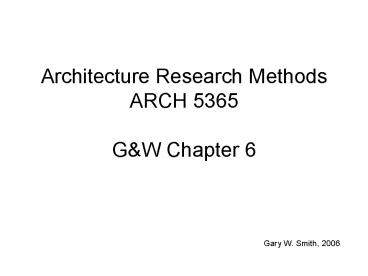Architecture Research Methods ARCH 5365 G - PowerPoint PPT Presentation
1 / 10
Title:
Architecture Research Methods ARCH 5365 G
Description:
... toward explaining those phenomena in narrative form and in a holistic fashion. ... Meaning defines an era. Poststructuralism takes a period of time as is. ... – PowerPoint PPT presentation
Number of Views:711
Avg rating:3.0/5.0
Title: Architecture Research Methods ARCH 5365 G
1
Architecture Research MethodsARCH 5365GW
Chapter 6
- Gary W. Smith, 2006
2
Interpretive-Historical Research
- Interpretive-Historical Research is investigation
into social-physical phenomena (past condition)
within complex contexts, with a view toward
explaining those phenomena in narrative form and
in a holistic fashion.
3
- Four parts to interpretive research
- Data/Evidence collection
- Identification/Organization
- Evaluation
- Narration
4
- The historian must take the available evidence to
weave together a coherent account. - Three components of analysis
- textual authentication
- validity of factual inferences
- weighing alternative interpretations
- All of these can include triangulation.
5
- Concept of Causal Explanations of History The
Idea of Covering Law - Involves the belief that social phenomenon CAUSE
or predict actions. (Hempel)
6
- Structuralism
- Similar to causal history in that actions
(designs) can be a response to structure or
structural analysis. - Poststructuralism
- Reality is a byproduct of discourse (the
cultural manifestations of the trafficking of
thought). Meaning defines an era. - Poststructuralism takes a period of time as is.
The material produces of culture are parts of a
larger immanent discourse.
7
- Six categories of classification of history
- politics
- biography
- ideas
- economy
- society
- mentality
- Writers must pull from all of the above in order
to weave its holistic account of the object in
question.
8
- Evidence must situate the object of study in the
time and place of one historic world. - Elements of the built environment are often used
to situate the object of inquiry in context.
9
- Inferential Evidence
- Can link one proposition or idea to another
through the use of logical deductions, proximal
dates, or reasoned interpretation - Recollective Evidence
- Interviews with people familiar with the topic
who were there when it happened or have intimate
details of the event(s)
10
- Tactics for Analysis of
- Architectural Structures
- On-Site familiarity
- Use of extant documents
- Visual inspection
- Material evidence
- Comparison with conditions elsewhere
- Use of local informants and lore
- Reenactment/testimonial
- Identification of remaining questions

